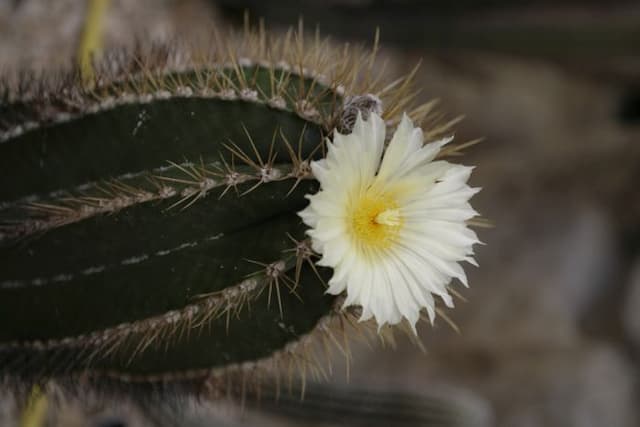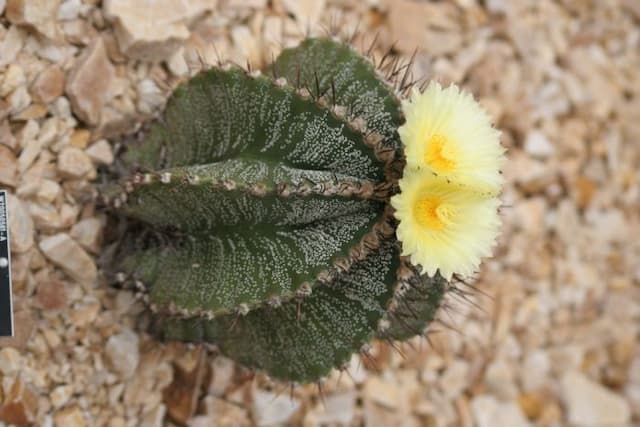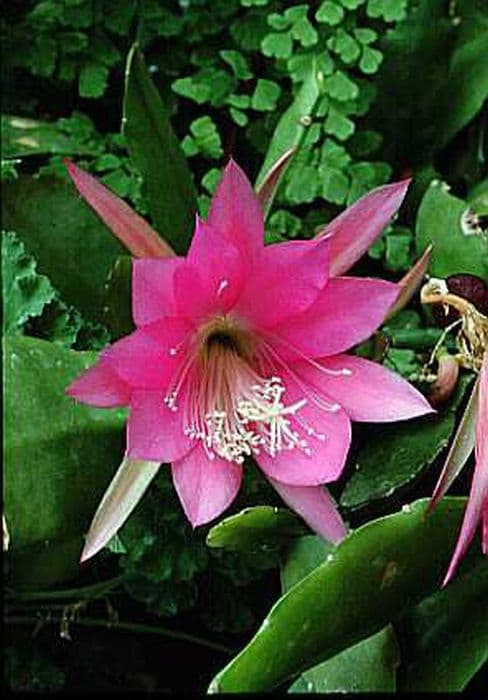Hedgehog Cactus Echinopsis spiniflora

ABOUT
Echinopsis spiniflora, also commonly known as the spiny-flowered hedgehog cactus, is a distinctive plant that features a green to bluish-green stem, which is often cylindrical or spherical in shape. The surface of the stem is adorned with raised, bumpy areas called tubercles, out of which sharp spines emerge. These spines are usually a creamy white to yellow color and can vary in length. The plant is known for its remarkable flowers, which typically bloom near the top of the stem. The flowers are large, funnel-shaped, and exhibit a variety of colors, often vibrant shades ranging from white to pink, red, or purple. Each flower is supported by a floral tube that is also covered in small spines and woolly hairs, enhancing the spiky texture of the plant. The appearance of the spiny-flowered hedgehog cactus is a charming blend of its stout, spiny stem and the contrastingly soft, often brilliantly colored flowers that seem to crown the plant when in bloom. The overall impression is one of a hardy, resilient plant well adapted to harsh conditions, yet capable of producing spectacular floral displays that add bursts of color to its native arid landscapes.
About this plant
 Names
NamesSynonyms
Spiny-Flowered Hedgehog Cactus, Sea-Urchin Cactus, Spring Cactus.
Common names
Echinopsis spiniflorus, Lobivia spiniflora, Chamaecereus spiniflorus, Pseudolobivia spiniflora, Echinopsis ancistrophora ssp. spiniflorus.
 Toxicity
ToxicityTo humans
Echinopsis spiniflora, commonly known as the Sea Urchin Cactus, is not known to be toxic to humans. There have been no significant reports of poisoning or adverse symptoms from ingesting this plant. However, as with many cacti, it is advisable not to ingest any part of the plant as a precaution and to avoid the sharp spines which can cause physical injury if handled improperly.
To pets
Sea Urchin Cactus, or Echinopsis spiniflora, is also not known to be toxic to pets. Like in humans, there is no significant evidence to show that ingestion of this plant by pets leads to poisoning. Nevertheless, the sharp spines of the cactus can cause physical injury to your pets, so it is best to keep the plant out of their reach.
 Characteristics
CharacteristicsLife cycle
Perennials
Foliage type
Evergreen
Color of leaves
Green
Flower color
White
Height
2 feet [61 cm]
Spread
2 feet [61 cm]
Plant type
Cactus
Hardiness zones
9
Native area
South America
Benefits
 General Benefits
General Benefits- Ornamental Value: Echinopsis spiniflora, commonly known as Hedgehog Cactus, adds aesthetic value to gardens and homes with its striking, spiny appearance and vibrant blooms.
- Drought Tolerant: Hedgehog Cactus requires minimal watering, making it an ideal plant for xeriscaping and water-efficient gardens.
- Low Maintenance: This plant requires little care once established, making it a good choice for novice gardeners or those with limited time.
- Attracts Pollinators: The colorful flowers of the Hedgehog Cactus attract bees and other pollinators, which are crucial for maintaining healthy ecosystems.
- Adaptive Growth: Hedgehog Cactus can thrive in a variety of soil conditions, as long as there is good drainage.
- Container Gardening: It is well-suited for container gardening, allowing for indoor cultivation or outdoor display on patios and balconies.
- Propagation: Echinopsis spiniflora can be easily propagated from offsets or seeds, making it simple to increase your collection or share with others.
 Medical Properties
Medical PropertiesThis plant is not used for medical purposes.
 Air-purifying Qualities
Air-purifying QualitiesThis plant is not specifically known for air purifying qualities.
 Other Uses
Other Uses- Echinopsis spiniflora, commonly known as the Hedgehog Cactus, is utilized in xeriscaping and drought-resistant gardens due to its low water requirements, offering an eco-friendly gardening solution.
- The Hedgehog Cactus serves as a food source for various desert wildlife, such as birds and bees, that rely on its nectar and pollen.
- The striking appearance of Hedgehog Cactus, with its vibrant flowers and unique form, makes it a popular choice for botanical illustrations and photography projects.
- Collectors of cacti prize Echinopsis spiniflora for its aesthetic value in cactus and succulent collections, often cultivating rare and exceptional specimens.
- Landscape designers incorporate Hedgehog Cactus into rock gardens for its sculptural qualities and ability to complement other stones and desert plants.
- Echinopsis spiniflora is used in educational settings, like schools and nature centers, to teach about plant adaptation and desert ecosystems.
- The flowers of the Hedgehog Cactus, being particularly vivid and large, are sometimes used in flower arrangements and as decorations once dried.
- Hobbyists may grow Echinopsis spiniflora to participate in cactus and succulent shows, competing against other growers for the most impressive specimens.
- Some artisan craftspeople might use the dried bodies or spines of Hedgehog Cactus in their art projects or as unique textures in mixed-media artwork.
- Cultural events and festivals in desert regions sometimes use local plants like the Hedgehog Cactus as symbols or motifs in their celebrations.
Interesting Facts
 Feng Shui
Feng ShuiThe hedgehog cactus is not used in Feng Shui practice.
 Zodiac Sign Compitability
Zodiac Sign CompitabilityThe hedgehog cactus is not used in astrology practice.
 Plant Symbolism
Plant Symbolism- Resilience: Echinopsis spiniflora, commonly known as "Hedgehog Cactus," often symbolizes resilience due to its ability to thrive in harsh, arid environments, where it retains water and endures intense sunlight.
- Protection: The spines of the Hedgehog Cactus serve as a natural defense mechanism, symbolizing the need for protection and setting personal boundaries.
- Adaptation: This cactus represents the ability to adapt to challenging situations, as it is highly adaptable to different light conditions and soils.
- Beauty and Surprise: The Hedgehog Cactus blooms with beautiful, showy flowers despite its spiny exterior, symbolizing hidden beauty and the element of surprise in life.
- Persistence: Its slow and steady growth rate stands as a testament to persistence and the value of long-term goals.
 Water
WaterSea Urchin Cactus requires moderate watering, generally about once a week during the active growing season. Water the cactus thoroughly, allowing the water to run through the drainage holes of the pot. Depending on the size of the pot and the plant, this could be approximately 16 to 32 ounces of water. During the winter months, reduce watering to once every three to four weeks as this cactus enters a dormancy period. Always ensure the soil is dry to the touch before watering again to prevent root rot.
 Light
LightSea Urchin Cactus thrives best in bright, indirect sunlight. It can handle some direct sun, especially in the cooler parts of the day, but intense afternoon sun can lead to sunburn on the cactus. The ideal spot for this plant would be in a room with east or west-facing windows or slightly shaded by a sheer curtain if placed in a south-facing window.
 Temperature
TemperatureSea Urchin Cactus prefers warm temperatures and should be kept between 50 and 85 degrees Fahrenheit. It can withstand temperatures as low as 40 degrees Fahrenheit, but it's best to avoid exposure to frost. The ideal temperature range for this cactus is 70 to 80 degrees Fahrenheit for optimal growth.
 Pruning
PruningSea Urchin Cactus doesn't require regular pruning, but it may benefit from the occasional removal of dead or damaged spines and flowers. Pruning can be done at any time of the year, but it's best done in the spring or early summer when the cactus is actively growing. If necessary, remove offsets to maintain the plant's shape and appearance.
 Cleaning
CleaningAs needed
 Soil
SoilThe best soil mix for Sea Urchin Cactus includes a well-draining cactus mix with added perlite or pumice to increase aeration; a pH level around 6.0 to 6.5 is ideal.
 Repotting
RepottingSea Urchin Cactus should be repotted every two to three years or when it outgrows its pot to ensure healthy growth.
 Humidity & Misting
Humidity & MistingSea Urchin Cactus prefers low to moderate humidity levels and can tolerate dry indoor environments without the need for additional humidity.
 Suitable locations
Suitable locationsIndoor
Place Sea Urchin Cactus in bright indirect light indoors.
Outdoor
Choose a sunny spot with some afternoon shade for Sea Urchin Cactus.
Hardiness zone
9a-11b USDA
 Life cycle
Life cycleThe Echinopsis spiniflora, commonly known as Sea-Urchin Cactus, begins its life cycle as a seed, often germinating in warm, moist soil in a process that can take several weeks. Upon sprouting, the seedling develops into a small cactus with a characteristic globular shape, and spines start to form as a defense mechanism. With proper care, including ample sunlight and minimal water, it goes through a vegetative growth phase, where it slowly increases in size. Over the years, when mature enough, typically in spring or early summer, the Sea-Urchin Cactus will produce large, showy flowers, usually at night, which are pollinated by nocturnal insects, birds, or bats. After pollination, fruits develop that contain new seeds, which when dispersed, can lead to the establishment of new plants, completing the cycle. The Sea-Urchin Cactus can live for several decades, and during its lifespan, it may go through the flowering and fruiting phase multiple times, depending on environmental conditions.
 Propogation
PropogationPropogation time
Spring to Summer
The Sea Urchin Cactus (Echinopsis spiniflora), can be propagated through offsets, which are small new cacti that grow from the base of the parent plant. The best time to remove and plant these offsets is during the cactus's active growing season, which is typically in the spring or early summer. Using a clean, sharp knife or pair of scissors, the offsets can be carefully severed from the main plant, ensuring that each piece has a portion of the root. The cuttings should then be allowed to dry and form a callus over the cut surface for a few days to a week. Once callused, the offset can be planted in well-draining cactus soil. The soil should be kept slightly moist but not waterlogged until the offset establishes roots, a process that may take a few weeks. During this time, it's important to provide bright, indirect light and avoid direct sunlight, which could scorch the young plant.









